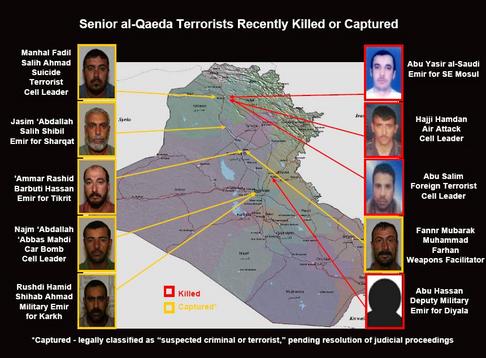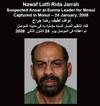As al Qaeda in Iraq is targeted in the northern city of Mosul, pressure continues to be applied to the terror network nationwide. US and Iraqi security forces have killed or captured 26 senior leaders of al Qaeda in Iraq’s terror network over the past several weeks, Major General Kevin Bergner, the spokesman for Multinational Forces Iraq said in a briefing in Baghdad on March 5. Many of those killed or captured have come from the northern regions, where al Qaeda is struggling to re-establish its network during a joint US and Iraqi military onslaught.
Eight of those killed were emirs, or leaders responsible for “a geographic or functional area,” five were cell leaders, and 13 were facilitators “involved in supporting the network of foreign terrorists, organizing the movement and security of senior leaders of the terrorist cells, or the making and use of improvised explosives and suicide vests,” Bergner said.
Bergner identified 11 of those killed or captured by name. The list highlights how al Qaeda’s operations have shifted from Anbar and Baghdad provinces to the northern provinces of Diyala, Salahadin, and Ninewa. Of those al Qaeda leaders identified, five operated in Mosul, two in Tikrit, one in Sharqat, and one in Baqubah, all in the north. Only two of those identified as killed or captured came from Baghdad.
• Abu Yasir al Saudi: Also known as Jar Allah, Yasir entered Iraq in August 2007 and rose through the ranks to lead al Qaeda operations in southeastern Mosul. He was killed in an airstrike along with Hajji Hamdan in Mosul on Feb. 27. He trained and fought in Afghanistan prior to entering Iraq.
• Hajji Hamdan: He led al Qaeda’s anti-aircraft teams in Mosul and the surrounding areas. He was killed in an airstrike along with Abu Yasir al Saudi in Mosul on Feb. 27. Hamdan was also a Saudi national.
• Abu Salim: An al Qaeda cell leader in Mosul who coordinated the movement of foreign terrorists into the Mosul region. He was killed on an unspecified date inside Mosul. Salim was also a Saudi national.
• Manhal Fadil Salih Ahmad: An al Qaeda cell leader in Abu Yasir al Saudi’s network in southeastern Mosul behind attacks on US and Iraqi forces. Ahmad was captured on an unspecified date.
• Nawaf Latfi Rida Jarrah: The commander of Ansar al Islam’s network in Mosul. He is behind attacks on US and Iraqi forces. Jarrah was captured on an unspecified date. Ansar al Islam is also known as Ansar al Sunnah, and has its roots in the Kurdish regions. Abu Abdullah al Hassan bin Mahmoud, the leader of Ansar al Islam, has close ties to Osama bin Laden. The terror group adheres to al Qaeda’s radical Salafi ideology. Military commander Abu Abdullah al Shafi has admitted to carrying out operations with al Qaeda. Ansar al Islam has refused to subordinate itself to al Qaeda in Iraq due to issues with al Qaeda in Iraq’s foreign leadership, several US military intelligence officials have told The Long War Journal.
• Ammar Rashid Barbuti Hassan: The emir of al Qaeda in Tikrit. Hassan also facilitated the movement of foreign terrorists into the region as well as made and transported weapons for attacks against US and Iraqi forces. Hassan was captured on an unspecified date.
• Fannr Mubarak Muhammad Farhan: An al Qaeda foreign terrorist and weapons facilitator, trainer, and jailer in Tikrit. He was captured in Tikrit.
• Najm Abdallah Abbas Mahdi: An al Qaeda cell leader that coordinated and carried out car bomb attacks and assassinations in Baghdad. He also moved weapons and explosives into southern Baghdad province. Mahdi was captured in Baghdad on an unspecified date.
• Jasim Abdallah Salih Shibil: Al Qaeda’s leader in Sharqat. He had previously operated in Bayji. Shibil was captured in Sharqat on an unspecified date.
• Rushdi Hamid Shihab Ahmad: Al Qaeda’s military leader for the Karkh district in Baghdad behind car bomb attacks in western and southern Baghdad. Ahmad was captured in Baghdad on an unspecified date.
• Abu Hassan: Al Qaeda’s deputy leader for Diyala province who led the regional car bomb network. Hassan was killed in Baqubah on an unspecified date.
Other al Qaeda leaders recently killed or captured in February not included in Bergner’s briefing include:
• Arkan Khalaf Khudayyir: A senior intelligence officer of al Qaeda in Iraq’s network in Diyala. Khudayyir, who is also known as Karrar, was instrumental in facilitating suicide bombing attacks in the Diyala River Valley and in Baghdad. He was behind several of the female suicide bomb attacks in Baghdad and Diyala. Khudayyir was killed in Khan Bani Saad on Feb. 17.
• An unnamed suicide bombing cell leader and recruiter north of Baghdad. The cell leader was recruiting women to carry out suicide attacks against Iraqis and Coalition forces. The cell leader/recruiter was captured in Ghailibiyah, just north of Khan Bani Saad, in Diyala province.
The success against al Qaeda’s leadership network in the North is the result of constant pressure against the terror group combined with the recruitment of the Sunni tribes and former insurgents to provide intelligence and security. The push against al Qaeda in the northern areas began after Baghdad and the surrounding regions, known as the Belts, were cleared during major combat operations during the summer of 2007. Multinational Forces Iraq and the Iraqi security forces first tackled the Za’ab triangle region, the area between Ninewa, Kirkuk (Tamin), and Salahadin provinces, followed by clearing operations in Diyala, then finally the Ninewa operation, said Brigadier General Tony Thomas, the deputy commander of Multinational Division North in a briefing on March 3.
US and Iraqi forces began focusing on the North in the late summer of 2007. Operation Lightning Hammer II, launched in early September, focused on the Za’ab triangle region. The Concerned Local Citizens – now known as the Sons of Iraq – were recruited to provide local security. This was followed by Operations Iron Hammer and Raging Eagle in November and Operation Iron Reaper in December 2007. In January 2008, Operation Phantom Phoenix was launched to target al Qaeda’s networks in the central and northern regions. Iron Harvest and Marne Thunderbolt, two subordinate operations to Phantom Phoenix, were launched in early January. Iron Harvest targeted al Qaeda’s networks in Miqdadiyah and wider Diyala province, while Marne Thunderbolt targeted al Qaeda’s networks in southern Baghdad province.










4 Comments
Quite an increase in tempo. Is this due to improved intelligence? Forcing AQ to relocate? Or is AQ flooding into Iraq for an offensive? All of the above? Something else?
As some know, MNF-Iraq each month has a press briefing dealing with operational updates against AQI leadership. Since July 2007, the numbers of senior AQI leaders killed or captured are:
February 2008 – 26
January 2008 – 35
December 2007 – 51
November 2007 – 40
October 2007 – 43
September 2007 – 29
August 2007 – 25
July 2007 – 19
As you can see, when the surge started in earnest in mid-June 2007, the general trend showed an increase in AQI senior leaders taken out. The last two months show a decrease. On the surface, this may demonstrate less success against AQI, however on the contrary this may indicate increased strategic success.
With the continuing of General Petraeus counter insurgency strategy, AQI areas of operations have shrunk dramatically. AQI holds less area that they control or even contest. As a result the demand for leadership positions has also shrunk. Put another way as in a business analogy, with less business, the AQI network has been forced to downsize their leadership positions, due to a lack of opportunity. The leadership positions simply no longer exist.
I would say al-Masri is definitely feeling the heat. My gut still tells me, he is somewhere in the northern Diyala/Hamrin Mountains region.
Cables, dispatches and memoranda
Cables, dispatches and memoranda.
As the Sunni’s changed thier minds about AQ, the intel started to flow. Wat is going on in Mosul sounds like Coalition forces want to remove AQ surgically, not by rolling the armor down the street, blasting. It sounds like AQ is weak, and they are hiding, so there will be no big battle. Sounds like the strategy is working. Picking them off in raids, running them into the dirt.